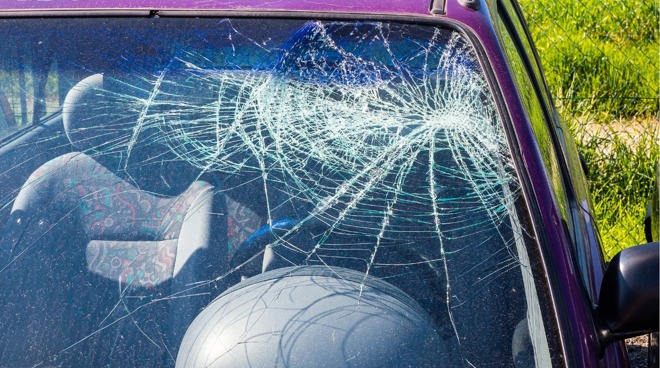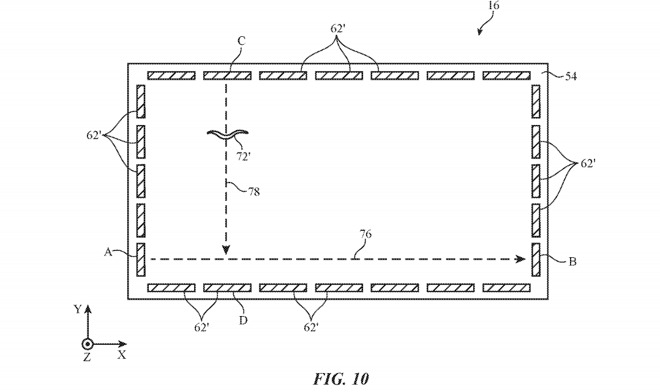The 'Apple Car' may be able to detect, warn drivers of cracked windows
The Apple Car may alert drivers to chips and cracks in the windshield and other windows, with a system that uses infrared light to determine if there are any issues with the glass, as well as giving an early warning to prevent small cracks getting larger.

One of the ongoing inescapable issues of driving are instances where a windscreen breaks. Chips and cracks can develop on a windscreen from stones and other debris flying into the glass at high speed, with the damage varying from small nicks to larger and potentially dangerous cracks.
While small amounts of damage may seem to be reasonable, a sudden jolt of the window could easily make the crack worse. Furthermore, cracks could allow air and moisture to pass through the glass, which in layered systems like a heating element film for a rear window, could affect the electronics.
In a patent granted by Apple on Tuesday by the US Patent and Trademark Office titled "Systems for detecting cracks in windows," Apple specifically targets windows in vehicles, though the same systems could easily be used in other areas, such as house windows.

Terminal strips around the edge can help detect where and how big a crack in the glass is.
The patent suggests the window could have an infrared-light-blocking layer, which is joined by a conductive layer on top, as well as control circuity. The circuitry has the ability to apply ohmic heating currents to the windows, which warms them up.
The conductive layer performs two tasks, with it used for resistance measurements and to assist with the ohmic heating.
Along the edges of the window are segmented terminals made up of elongated metal strips, which are used to apply the ohmic heating current. These same strips are also able to make electrical measurements, reading emissions from other terminals transmitted through the conductive layer.
When a crack forms in a window, it breaks parts of the glass layer sandwich, which in turn affects how the conductive layer passes electricity through to other terminals. Specifically, the changes to the conductive layer introduces resistance, which are then measured.

A crack can interfere with other layers in the glass stack.
By using multiple terminal strips around the outside, the system can create a map of resistance across the glass surface, and can determine the general position, size, and possibly shape of the cracked area. By selectively enabling and disabling the terminals, this map could focus on the cracked area more and provide increased detail for the system to use.
The patent lists its inventors as Martin Melcher, Christopher D. Jones, and James R. Wilson. The application was filed on July 14, 2017.
Apple files numerous patent applications on a weekly basis, but while the existence of a patent indicates areas of interest for Apple's research teams, it doesn't guarantee the existence of the idea in a future product or service.
Obviously, the patent has its primary use for the Apple Car, the long-rumored Apple-designed vehicle, however it may have more utility than some may realize. Apple has filed numerous patent applications for car-related ideas that involve glass and the windscreen itself, with each easily benefiting from a system that detects glass damage.
In August, it gained a patent for embedding a display into a car window, while in 2019 it suggested adding fiber optic elements to windows. An earlier filing gave more of an idea of Apple's vision for the Apple Car, with an AR view for the driver showing the route ahead.
Away from the windscreen, Apple has also looked at creating a "moon roof" with automatically tinting windows, again relying on layers within windows to adjust the transparency. A patent for "synchronized windows" suggested using a liquid crystal layer working in combination with an internal light to refresh and block the internal light from being emitted from the vehicle, while still allowing passengers to see outside.

One of the ongoing inescapable issues of driving are instances where a windscreen breaks. Chips and cracks can develop on a windscreen from stones and other debris flying into the glass at high speed, with the damage varying from small nicks to larger and potentially dangerous cracks.
While small amounts of damage may seem to be reasonable, a sudden jolt of the window could easily make the crack worse. Furthermore, cracks could allow air and moisture to pass through the glass, which in layered systems like a heating element film for a rear window, could affect the electronics.
In a patent granted by Apple on Tuesday by the US Patent and Trademark Office titled "Systems for detecting cracks in windows," Apple specifically targets windows in vehicles, though the same systems could easily be used in other areas, such as house windows.

Terminal strips around the edge can help detect where and how big a crack in the glass is.
The patent suggests the window could have an infrared-light-blocking layer, which is joined by a conductive layer on top, as well as control circuity. The circuitry has the ability to apply ohmic heating currents to the windows, which warms them up.
The conductive layer performs two tasks, with it used for resistance measurements and to assist with the ohmic heating.
Along the edges of the window are segmented terminals made up of elongated metal strips, which are used to apply the ohmic heating current. These same strips are also able to make electrical measurements, reading emissions from other terminals transmitted through the conductive layer.
When a crack forms in a window, it breaks parts of the glass layer sandwich, which in turn affects how the conductive layer passes electricity through to other terminals. Specifically, the changes to the conductive layer introduces resistance, which are then measured.

A crack can interfere with other layers in the glass stack.
By using multiple terminal strips around the outside, the system can create a map of resistance across the glass surface, and can determine the general position, size, and possibly shape of the cracked area. By selectively enabling and disabling the terminals, this map could focus on the cracked area more and provide increased detail for the system to use.
The patent lists its inventors as Martin Melcher, Christopher D. Jones, and James R. Wilson. The application was filed on July 14, 2017.
Apple files numerous patent applications on a weekly basis, but while the existence of a patent indicates areas of interest for Apple's research teams, it doesn't guarantee the existence of the idea in a future product or service.
Obviously, the patent has its primary use for the Apple Car, the long-rumored Apple-designed vehicle, however it may have more utility than some may realize. Apple has filed numerous patent applications for car-related ideas that involve glass and the windscreen itself, with each easily benefiting from a system that detects glass damage.
In August, it gained a patent for embedding a display into a car window, while in 2019 it suggested adding fiber optic elements to windows. An earlier filing gave more of an idea of Apple's vision for the Apple Car, with an AR view for the driver showing the route ahead.
Away from the windscreen, Apple has also looked at creating a "moon roof" with automatically tinting windows, again relying on layers within windows to adjust the transparency. A patent for "synchronized windows" suggested using a liquid crystal layer working in combination with an internal light to refresh and block the internal light from being emitted from the vehicle, while still allowing passengers to see outside.

Comments
When you replace the windshield, you'll also have to replace the rear axel and the seatbelts, because somehow they will be integrated and can't be repaired independently
(Gah! Can't stand this new AppleInsider article-forum setup. it's terrible!)
Also AI: shows a picture of a windshield hit by a meteor as an example of "chips and cracks".
Also, also AI: hit by meteor, the person's dash displays a CRACK DETECTED warning red light
Also, also, also AI: annoyed, the person puts a piece of electrical tape over warning light and keeps driving. Confidently driving with the knowledge that it will buff right out.
Also in making their software work better for disabled users - try hiring some disabled people to help with testing, nd product evaluation.
Word has it that Apple and Capt O are also working on a patent that tells the driver whether they are actually sitting in their Apple Car as opposed to just having an out-of-body experience or a dream that involves them sitting in an Apple Car. I think it's based on some sort of upward facing probe technology embedded in the Apple Seat that imparts a sensory signal to generate a physical response from the user. It's probably based on a tiny piezoelectric generator that takes advantage of butt-cheek-capacitance (BCC) to determine when the driver is actually in contact with the driver's seat and not hovering above the seat in the ether as would be the case for a typical out-of-body scenario.